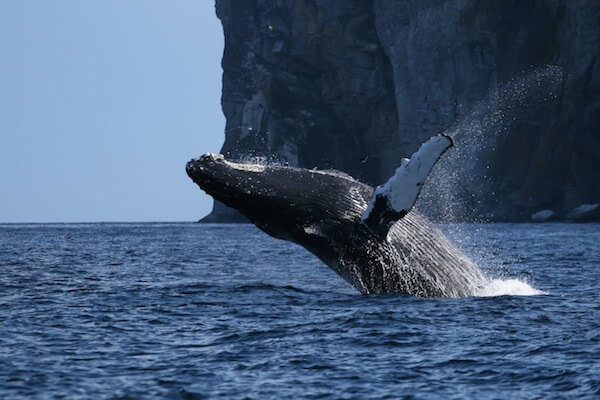Early in the morning of September 17, under an overcast sky and in glassy seas, two observers from Sainte-Anne-des-Monts are keeping their eyes peeled for the movements of two humpback whales. Despite the distance, the absence of wind enables them to hear their spouts and the telescope, to discern the black-and-white colour pattern under their tails. The same day, on the other side of the St. Lawrence River in Pointe-des-Monts, a local resident notes three humpback whales and two fin whales, all quite close to the coast and in a surprisingly shallow location.
Blue whales and fin whales are commonly found in deep waters, where water mixing is conducive to prey aggregation (zooplankton, fish). Occasionally, such prey draw these hunters into shallower waters, sometimes even to the detriment of their lives (risk of stranding, entanglement, etc.). In other places, rugged underwater relief provides for observations close to shore. This is the case of Cap de Bon-Désir in Les Bergeronnes. Just a few metres off the boulders lies an underwater valley: the Laurentian Channel. Passing by the foot of this lookout this week were two humpback whales, a fin whale, a dozen or so minke whales and harbour porpoises. At sea, whale-watchers encounter the humpback Bad Chemistry and her newborn. The pair dives in perfect synchrony.
Temporarily based in Gaspé, part of the team from the Mingan Island Cetacean Study (MICS) is continuing its research efforts to find the giant of the giants: the blue whale. Without success for the time being. To do so, the team does not hesitate to venture out into the immensity of the Gulf of St. Lawrence. “The animals – 30 to 40 humpbacks, 15 to 20 fin whales and several minke whales – are all concentrated between L’Anse-au-Griffon and Cap Gaspé,” says Richard Sears, director and founder of MICS. Whale-watching operators in the region have also been directing their efforts toward the Cap Gaspé sector, where they cross paths with some one hundred white-sided dolphins and several bluefin tuna. Like dolphins, tuna are powerful swimmers that can reach speeds of up to 30 km/h. In comparison, dolphins can reach peak velocities of between 25 and 45 km/h, but their cruising speed is closer to the order of 15 km/h. White-sided dolphins are also known for their aerial acrobatics. Tuna only display such feats on occasion.
In fact, Jacques Gélineau, a collaborator for the Nordic Institute for Environmental and Occupational Health Research (INREST) in Sept-Îles, gawks at one of these fish leaping before his eyes. The animal measures 2 m long and is dark blue with light blue sides. In summer, bluefin tuna come to feed in the St. Lawrence River. They tolerate a wide range of temperatures and migrate over great distances to the Gulf of Mexico, where they spawn in winter.
Also in Sept-Îles, the trend predicted by Mr. Gélineau a few weeks ago whereby “The winds will help concentrate prey closer to the coasts, and the whales won’t be far behind” proves to be true, notes this collaborator. All the animals he observes – two pairs of blue whales, six fin whales and several harbour porpoises – are within 5 km of the coast. Also, the same three humpbacks that have been seen for several weeks in the Bay of Sept-Îles are still there. “They’ve taken root,” says Gélineau. In fact, Anik Boileau, director of the Sept-Îles Education and Research Centre (CERSI), states that “observing one of these humpbacks since as as far back as June 16 is a first for the region.” The humpback is a relatively “coastal” whale. It feeds in bays and inlets and breeds near tropical islands.
In summer, the harbour porpoise, a small coastal cetacean, frequents fjords, bays, estuaries and even harbours, hence its name. Several groups of porpoises have been observed in the Sainte-Anne-des-Monts region. On September 13, near American Bank in the southern part of the Gulf, the Fisheries and Oceans Canada team on board the Teleost tallies approximately 100 harbour porpoises. And they are not alone: white-sided dolphins, some thirty humpbacks, fifteen or so fin whales and multiple minke whales are also spotted in the sector!
Minke whales regularly frequent the St. Lawrence shoreline. Some even linger in the Saguenay up to ten kilometres upriver. On September 15, there were many at the mouth of the Saguenay, surface feeding with the aid of the currents, rock walls and even the hulls of boats. These complex manoeuvres are even depicted in Renaud Pintiaux’s most recent Field Notes.






